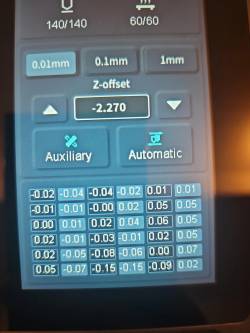Table of Contents
What do the numbers on the Level screen tell me?
Answer
Nothing useful.
Discussion
This is the Level dashboard of the Screen.
What are the numbers?
Heater Temps
At the very top of the screen here we see the current/set temperature values for the extruder and the bed. These are set normally through your gcode when you print yet they could have been set manually. In this case while the value of 60C for the bed is adequate for printing PLA the value for the extruder is below temperature for printing PLA, might be set to this value to pre-warm the nozzle.
gcode z offset
In the middle we see what the screen believes is the current gcode z_offset. I say “what the screen believes” because this may not be the actual currently set value for the gcode z offset set on the printer as the screen doesn't automatically live update and the ancillary side screen is just one controller of the actual printer. The Screen also does not set the z offset absolutely, but relatively, by 0.01mm, 0.1mm, or 1mm relative to what it believes is the current z offset value. For this reason it's advised not to set the gcode z offset here, yet to use the console or Fluidd controllers.
Given the gcode z offset is a /negative/ value we know the z probe is not calibrated, and it's negative because it's including an error adjustment to account of the lack of calibration.
Auxiliary and Automatic buttons
Here we find two buttons with poor names.
The first, Auxiliary, invokes a manual bed leveling workflow that uses the paper method to attempt to level the bed. There's nothing “auxiliary” about it however as we must level the bed, yet this workflow is well known to be grossly subjective, highly inaccurate, and should not be used to level the bed. See and use SCREWS_TILT_CALCULATE instead.
The second button, “Automatic” has nothing to do with the bed level at all and invokes a workflow to create a full bed mesh. “Automatic” is an unfortunate term as it implies “automatic bed leveling” which it is not as it has nothing to do with how /level/ the bed is, it is about measuring how /flat/ the bed isn't. The values of the bed mesh are generally irrelevant as it's just a scan of the bed plate and the calculated amount of compensation Klipper\ will apply when printing mitigate for the plate being warped. All bed plates are,
While a full bed mesh may be useful for evaluating the warpage of the plate to assure we don't have too much plate tension, we should not be using these stale full or saved bed meshes for production printing, we shoudl be using an adaptive bed mesh that's fresh and generated at print time.
Table of bed mesh numbers
Next we find a table of numbers. These supposedly represent the bed mesh, however there are several issues.
First these would be the probed bed mesh values and not the interpolated bed mesh that's actually used for printing.
Second, and more critically, the table only supports six columns of numbers. If you're using a 6 x 6 bed mesh, like we observe in the picture, then we're seeing all the values, even though they aren't the values used for printing. However if you have a large bed mesh, like Elegoo's “Professional” setting on the Screen, then the table is incapable of displaying all the mesh values and we have no idea which are or aren't being displayed making the table useless.
Conclusion
The only thing we can usefuly tell from this particular picture is that the z probe isn't calibrated.
